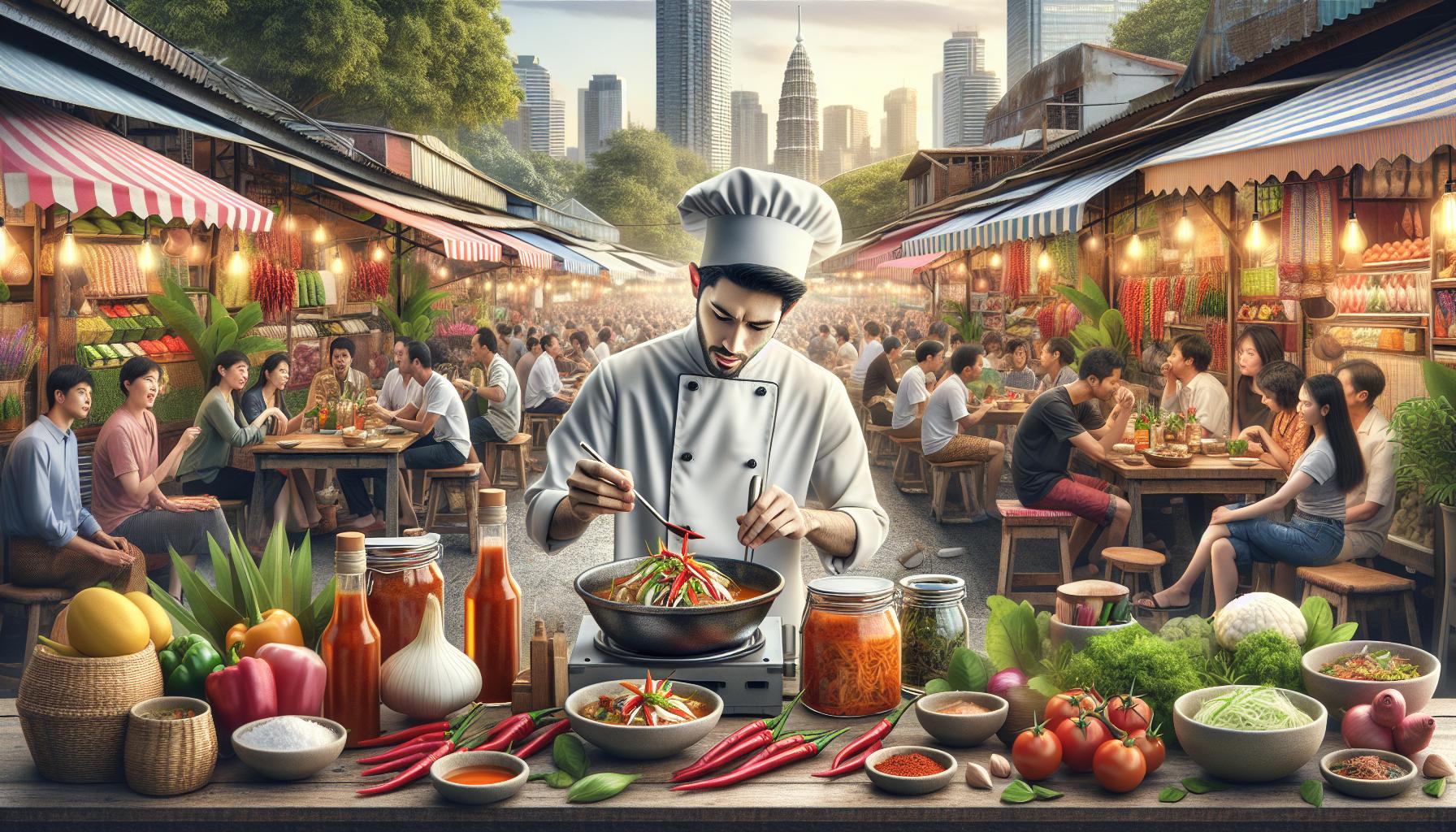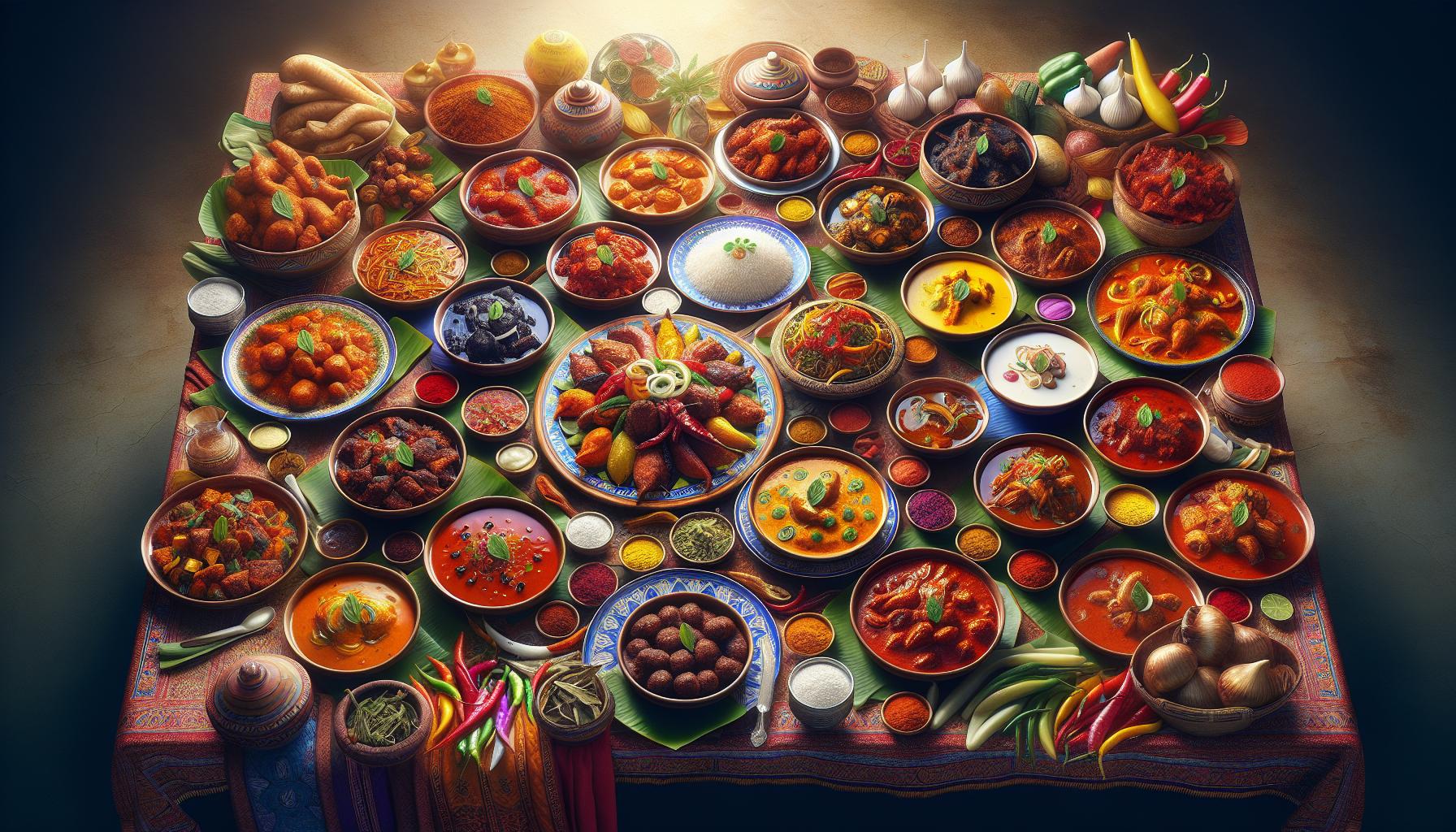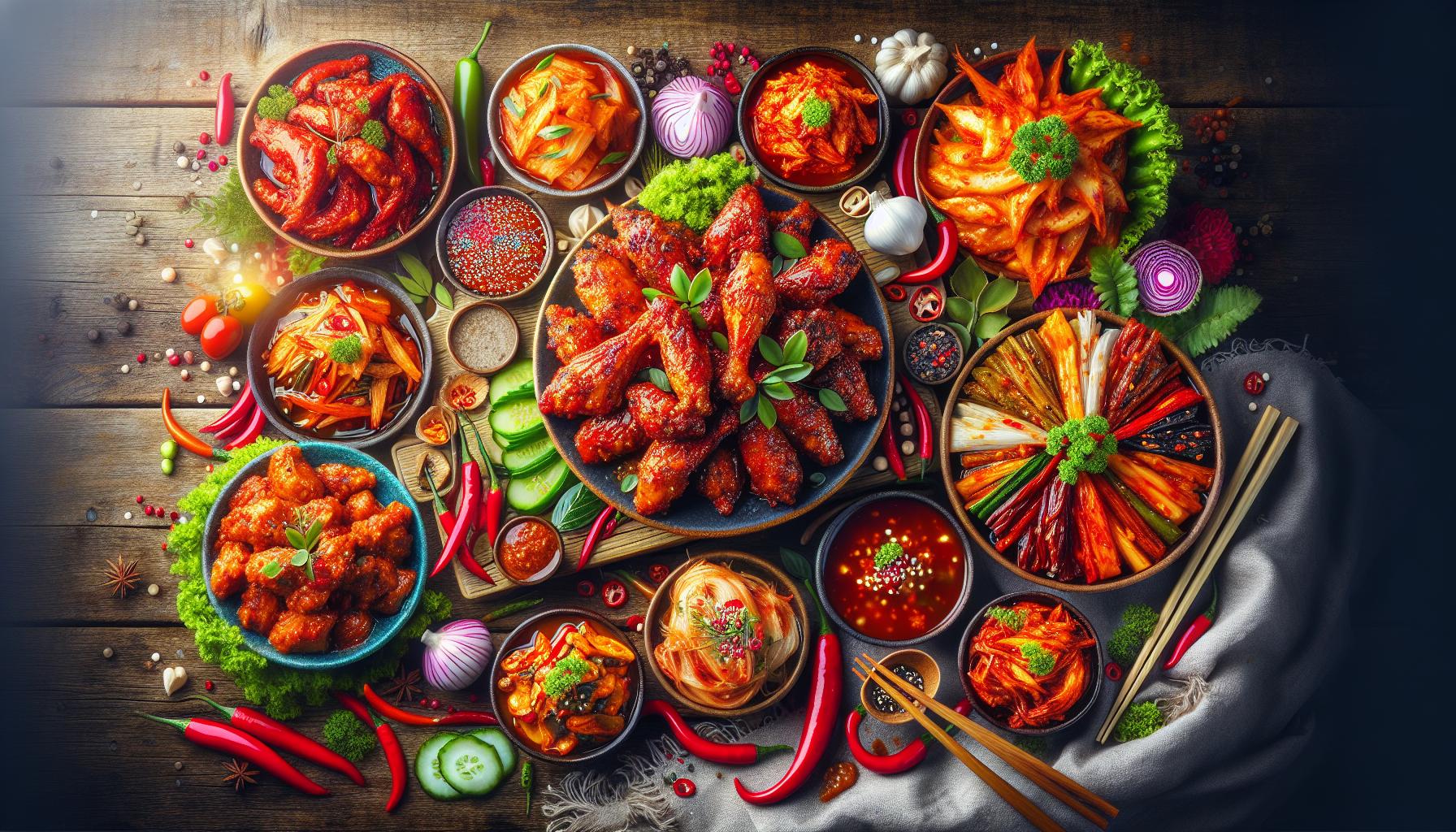When it comes to setting taste buds on fire, some cultures take their spice game to extreme levels. From tongue-numbing Sichuan peppercorns to volcanic Thai chilies, the world’s spiciest cuisines compete in an unofficial heat index that’ll make even the bravest food enthusiasts break a sweat.
While many might assume Indian curry holds the crown for maximum heat, several other culinary traditions pack an equally powerful punch. The global spice race spans continents, with each region boasting its own unique blend of peppers and seasonings that’ll send diners reaching for water – or better yet, milk. Let’s explore which cultures truly bring the heat and discover why some societies have embraced the art of culinary torture as their gastronomic claim to fame.
What Culture has the Spiciest Food
Measuring the heat level in spicy foods requires standardized scientific methods to accurately compare different peppers and dishes. These measurements help chefs and consumers understand spice intensity across various cuisines.
The Scoville Scale Explained
The Scoville Heat Unit (SHU) scale measures capsaicin concentration in peppers through precise dilution tests. Pure capsaicin ranks at 16 million SHU, while bell peppers register 0 SHU. Professional taste testers determine heat levels by diluting pepper extracts in sugar water until the spiciness becomes undetectable. Modern labs use high-performance liquid chromatography (HPLC) for more accurate readings. The scale ranges from mild jalapeños at 2,500-8,000 SHU to extreme varieties like the Carolina Reaper at 1.4-2.2 million SHU.
Different Types of Chili Peppers
Chili peppers span diverse heat levels across multiple varieties worldwide. Ghost peppers measure 855,000-1,041,427 SHU, making them 400 times hotter than jalapeños. Scotch Bonnets rate 100,000-350,000 SHU, appearing frequently in Caribbean cuisine. Thai Bird’s Eye chilies range from 50,000-100,000 SHU, serving as a cornerstone in Southeast Asian dishes. Habaneros clock in at 100,000-350,000 SHU, featuring prominently in Mexican cooking. The Trinidad Scorpion reaches up to 1.4 million SHU, competing with the Carolina Reaper for the world’s hottest pepper title.
| Pepper Type | Scoville Heat Units (SHU) |
|---|---|
| Bell Pepper | 0 |
| Jalapeño | 2,500-8,000 |
| Thai Bird’s Eye | 50,000-100,000 |
| Scotch Bonnet | 100,000-350,000 |
| Ghost Pepper | 855,000-1,041,427 |
| Carolina Reaper | 1,400,000-2,200,000 |
Thai Cuisine’s Fiery Reputation

Thai cuisine incorporates intense heat through Bird’s Eye chilies balanced with sweet coconut milk galangal lemongrass. The layered complexity of Thai spiciness creates distinctive flavor profiles that consistently rank among the world’s hottest culinary traditions.
Popular Spicy Thai Dishes
Thai restaurants classify spiciness levels from 1-5 stars with authentic preparations reaching extreme heat levels. Som tam (green papaya salad) incorporates raw Bird’s Eye chilies creating an explosive heat intensity of 50,000-100,000 SHU. Tom Yum soup combines fragrant herbs with floating chili oil delivering concentrated spice in every spoonful. Pad Kra Pao (holy basil stir-fry) features minced chilies that release capsaicin oils throughout the dish. Nam Prik Pao (chili paste) serves as a condiment adding 30,000-50,000 SHU when used in dishes like Pad Thai or Khao Soi.
Regional Heat Variations
Southern Thai cuisine maximizes heat levels using fresh Bird’s Eye chilies in curries reaching 100,000 SHU. The northeastern Isaan region incorporates dried chilies into dishes like Laab (meat salad) adding sustained heat throughout the meal. Northern Thai cuisine moderates spiciness focusing on complex herb combinations while maintaining 20,000-40,000 SHU heat levels. Central Thailand balances extreme spice with coconut milk creating signature curries that build progressive heat intensity. Bangkok street food vendors customize spice levels adapting to both local preferences maintaining 30,000-50,000 SHU international palates.
Indian Culinary Heat

Indian cuisine showcases diverse heat levels through intricate spice combinations including red chilies, black pepper, ginger root. Regional variations across the subcontinent demonstrate distinct approaches to spiciness in traditional dishes.
Northern vs Southern Indian Spice Levels
Southern Indian cuisine features higher heat levels than its northern counterpart, with states like Andhra Pradesh reaching 100,000+ SHU in traditional dishes. Coastal regions incorporate more chilies due to their natural preservation properties. Tamil Nadu specializes in intensely spiced chutneys reaching 75,000 SHU. Northern Indian cooking balances heat with cream-based curry sauces averaging 20,000-30,000 SHU. Punjab emphasizes aromatic spices over pure heat while Kerala blends multiple chili varieties for layered spiciness. Regional climate patterns influence spice usage with southern states growing hotter varieties of chilies.
Essential Spicy Indian Dishes
Phaal curry ranks as India’s spiciest dish at 1,000,000+ SHU using ghost peppers as its base. Vindaloo from Goa incorporates Portuguese influences with spice levels reaching 350,000 SHU. Andhra-style Chicken 65 combines red chilies with black pepper for 200,000+ SHU heat intensity. Chettinad cuisine features signature pepper chicken utilizing 20+ spices reaching 150,000 SHU. Laal Maas from Rajasthan combines mathania chilies with spices for 100,000 SHU heat levels. These dishes demonstrate regional cooking techniques through their distinctive spice combinations.
| Dish | Region | Scoville Heat Units (SHU) |
|---|---|---|
| Phaal Curry | Hyderabad | 1,000,000+ |
| Vindaloo | Goa | 350,000 |
| Chicken 65 | Andhra Pradesh | 200,000+ |
| Chettinad Chicken | Tamil Nadu | 150,000 |
| Laal Maas | Rajasthan | 100,000 |
Korean Heat Culture

Korean cuisine embraces intense heat through fermented chili products and traditional cooking methods. The spice levels in Korean dishes range from 10,000 to 200,000 SHU, depending on the preparation and ingredients used.
Gochugaru and Gochujang
Gochugaru delivers concentrated heat through sun-dried red chili flakes, measuring 4,000-8,000 SHU. Korean cooks ferment these chilies to create gochujang, a red pepper paste that reaches up to 50,000 SHU. The fermentation process combines glutinous rice, fermented soybeans, salt with gochugaru to produce complex flavors beyond pure heat. Gochujang adds depth through amino acids that develop during its 6-month aging period in traditional clay pots called onggi. Modern commercial varieties maintain consistent heat levels between 30,000-40,000 SHU.
Traditional Spicy Korean Favorites
Buldak leads Korean spicy dishes at 150,000-200,000 SHU with its fire chicken preparation using gochugaru paste. Kimchi demonstrates traditional fermented heat, ranging from 1,000 SHU for white kimchi to 100,000 SHU for specialized varieties. Tteokbokki combines rice cakes with gochujang sauce reaching 75,000 SHU in street food versions. Sundubu-jjigae spicy tofu stew incorporates fresh chilies with gochugaru for 50,000 SHU of warmth. Regional variations like Andong-style jjimdak balance heat with soy sauce at 30,000 SHU.
Mexican Spice Traditions
Mexican cuisine harnesses the power of native chili peppers to create distinct flavor profiles across regional dishes. The integration of various peppers ranges from mild poblanos at 1,000-2,000 SHU to intense habaneros reaching 350,000 SHU.
Historic Use of Chili Peppers
Archaeological evidence dates Mexican chili pepper cultivation to 7,500 BCE in the Tehuacán Valley. Ancient Aztecs combined chilies with cacao for xocolatl, their sacred drink. The Mayans used chilies as currency alongside ceremonial practices. Spanish conquistadors encountered these peppers in the 16th century, documenting their use in traditional Mexican dishes. Regional variations developed as communities adapted different pepper varieties to local tastes. Central Mexican cuisine incorporated mild chilies like ancho (1,000-2,000 SHU), while Yucatan embraced habaneros (100,000-350,000 SHU).
Signature Hot Mexican Dishes
Traditional Mexican moles incorporate multiple chili varieties, reaching heat levels of 50,000 SHU. Salsa habanera from Yucatan delivers intense heat at 200,000 SHU. Aguachile features raw serrano peppers (10,000-25,000 SHU) in citrus marinade. Chilate poblano combines dried chilies creating complex heat profiles of 40,000 SHU. Street tacos al pastor feature adobo sauce with guajillo chilies (2,500-5,000 SHU). Pozole rojo incorporates dried arbol chilies (15,000-30,000 SHU). The iconic chile en nogada balances mild poblano peppers with sweet pomegranate seeds.
| Mexican Dish | Scoville Heat Units (SHU) |
|---|---|
| Salsa Habanera | 200,000 |
| Aguachile | 10,000-25,000 |
| Chilate Poblano | 40,000 |
| Pozole Rojo | 15,000-30,000 |
Other Notable Spicy Cuisines
Global cuisines feature distinct approaches to spicy food with unique ingredients creating memorable heat experiences. Each region embraces local peppers paired with traditional cooking methods to develop signature flavors.
Sichuan Chinese
Sichuan cuisine combines numbing Sichuan peppercorns with fierce chili oil reaching heat levels of 50,000-75,000 SHU. The signature mala flavor combines hydroxy alpha sanshool from peppercorns with capsaicin from dried chilies creating a tingling sensation. Popular dishes include Mapo Tofu at 50,000 SHU Chongqing Laziji at 75,000 SHU Shuizhu beef at 65,000 SHU. Chefs layer multiple forms of heat using fresh chilies dried peppers chili oil paste fermented broad bean paste.
Caribbean Heat
Caribbean cuisine incorporates scotch bonnet peppers ranging from 100,000-350,000 SHU across signature dishes. Jamaican jerk seasoning combines scotch bonnets with allspice thyme creating heat levels of 200,000 SHU. Traditional dishes showcase regional variations: Trinidad Scorpion pepper sauce reaches 1.2 million SHU Barbados pepper pot averages 150,000 SHU Guyanese curry incorporates wiri wiri peppers at 100,000 SHU. Local marinades rubs sauces feature complex spice blends built around potent chilies balanced with tropical ingredients.

